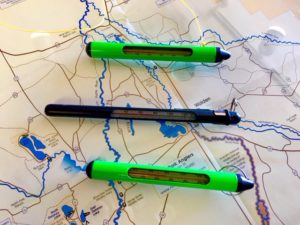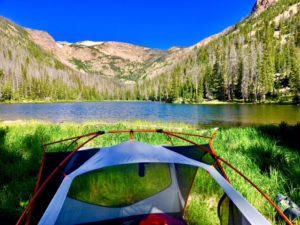July 26, 2018

Marcia learning to fly fish for the first time during the all ladies lodge group at the Buffalo Creek Ranch.
Last week we hosted an all women’s group at our private fly fishing and hunting lodge on the Buffalo Creek Ranch (http://buffalocreek.com/ ). It was four full days of badass chicks fly fishing, hiking and trap shooting and for me personally, after spending my entire summer with dudes, it was a breath of fresh air. As expected, I was asked lots of questions about how I got into fly fishing and why I decided I wanted to be a guide. After spending four days with these ladies, teaching them how to fish, hearing their stories, watching them play outside and truly enjoy their time spent in the dirt, I started to think about my own story and experiences and what it’s like to be a female in the fly fishing industry. Recently, Orvis has launched a new initiative called 50/50 On The Water that aims to “inspire and celebrate women in the sport we all love,” (https://5050onthewater.orvis.com/). Since the launch of the 50/50 initiative, Orvis has received many mixed responses, both those who think the campaign is awesome and innovative, and backlash from those who believe it is simply a marketing ploy and is starting a “battle of the sexes.” After seeing both sides of the argument, I started really thinking about my personal experiences of getting into fly fishing and what it’s been like working in the male-dominated industry. This post is not intended to be political or trying to spark argument, I wanted to write it to share my personal story and try to connect with other ladies, as well as help us anglers see around potential blindspots. This is my story:
Growing up, I spent a lot of time in North Park. My father spent his summers as a kid up here fly fishing, tying flies for the gas station and helping control the gopher population. For the first 16 years of my life, the majority of my time up here was spent eating homemade biscuits and gravy, chasing Wile E. Coyote with a .243, tying knots in my fly line, and getting really good at netting my father’s fish. I loved being outside and I loved hanging out with my dad on the water, but quite honestly, I sucked at fly fishing and preferred to spend my time playing with bugs and netting fish instead of untangling my line all day.
When my dad first mentioned the idea of going on a guided fly fishing trip with North Park Anglers, I would have rather poked a sharp stick in my eye. There was no way I was about to spend all day on the water with some dude I didn’t know and let him boss me around. I was convinced that I was going to be the laughing stock of the day, that I wouldn’t be able to pee until we got home, and that I was going to have to pretend to like hardcore fishing for eight hours. I was intimidated and nervous, but I finally gave in for the sole reason that I wanted to make my dad happy and hang out with him. After connecting with other lady anglers, I’ve learned that many of us felt similar emotions when we first got into fly fishing. No one has ever created physical barriers for us, but the emotional ones were definitely present and that’s what 50/50 On The Water is trying to mitigate and eliminate. When the day of the guide trip came around, I felt like I was walking into my first day of high school as a freshman. I had a slight idea of what I was doing, but I decided that I wanted to start fresh and re-learn what I already knew about fly fishing in the hopes that my guide would be able to explain things in a different, more understandable way than my dad could. By the end of the day I was sunburned, had caught fish bigger than I could hold, was freshly educated on how to fish a river and ready for more. Every weekend after that I was cancelling shopping trips and skipping high school football games with my friends in Denver to come fishing with my dad in North Park. I was hooked…pun intended.

My very first guide trip that would unknowingly spark a life-long passion.
Fast forward a few years and I’m spending my summer under the wings of some of the best fly fishing guides in the state and eventually get hired to work alongside them. When people talked about barriers for women, I never really understood or related to what they were talking about (I always thought my nervousness of going on my first guide trip was just me being worried about making a fool of myself). I grew up outside, playing in the dirt, hunting, fishing, camping, and trying my very hardest to be just like my dad and brother (shout out to my mom for reminding me to brush my hair every once in a while and for washing the grass stains out of my clothes). It wasn’t until I started working in the male-dominated industry that I really started to feel the effects of being a woman in the sport. My coworkers are some of the greatest people I’ve ever met and never once have I felt like an outcast or belittled by them because of my gender. I’ve never felt disrespected or not taken seriously by them. They don’t give me special treatment or extra hand holding, I’m just another one of the guides and I’m expected to pull my weight just as much as any of them. Working in the shop and talking to customers is when I started to notice the lack of respect and acknowledgement for female anglers. Again, this post is not intended to spark argument, I simply want to share my experiences. Over the past three months I’ve had some pretty disturbing and insulting comments said to me and about me, but by far the most annoying situations are the ones where customers avoid me and are dismissive. For example, I have been asked if there was a guy around who could answer questions about fishing instead of myself and I have had customers go into full blown conversations with my coworker after dismissing me and my advice, only to get the same advice from my male coworker.
I think it’s safe to say that 80% of the time people are very respectful, take me seriously, and listen to what I have to say. Once you cut out the shenanigans of disrespectful anglers, in my experience, being a woman in the fly fishing industry is not that much different than being a man.
So, as a woman, what is my opinion of Orvis’s 50/50 On The Water campaign? I think it’s a good start and in the long run is going to help the industry advance the technology for women in fly fishing. Do I believe it’s simply a marketing ploy? No, but it’s no secret that you’re going to have to spend money to get into a new sport and if big name companies such as Orvis are taking a serious approach to designing quality and functional gear for women, then of course they’re going to make money off of us. Besides, most anglers both men and women choose to buy their gear from local fly shops, so adding to the population of fly anglers is going to help keep our local and friendly fly shops around and in business. I also believe the 50/50 On The Water movement is going to help normalize women in fly fishing. Walking into a fly shop and seeing female guides, employees and anglers will become less of a shock, the idea around a “battle of the sexes” is going to die off, and more companies will finally start getting as serious about making functional gear for women as they do for men.
I really do think 50/50 On The Water is helping women feel more confident and comfortable when venturing into fly fishing. For example, this summer I’ve had days on the water with my friends where there were equal numbers of men and women and even a few days where there were more women than men. At the beginning of the summer, two girls who had a summer job with Parks and Wildlife walked into the fly shop to get fishing licenses. Over the course of a five minute conversation, I learned that they had all the gear for fly fishing, but were new to it and trying to learn. I told them about 50/50 On The Water and offered to fish with them after work one day. We swapped cell phone numbers, and they quickly became some of my best (and only) girl friends in this small town this summer.

The effects of 50/50 On The Water with my new-found Parks and Wildlife friends.
Working and guiding for North Park Anglers is one of the best experiences of my life, despite the backlash and disapproval I sometimes get from outsiders. My goal coming here was to provide an inviting, fun and non-intimidating experience for women looking to get into fly fishing but haven’t taken the first steps yet because they don’t want to hang around a strange dude on a river all day. North Park Anglers has embraced that goal and is working towards being a shop that everyone feels welcomed and comfortable in, and provide advice and service that people can trust regardless of gender. Fly fishing is a universal sport and I think with the help of friendly fly shops, good people and programs such as 50/50 On The Water, together men and women can keep the sport and conservation that comes with it in generations for years to come.
Written by: Taylor Martin
























